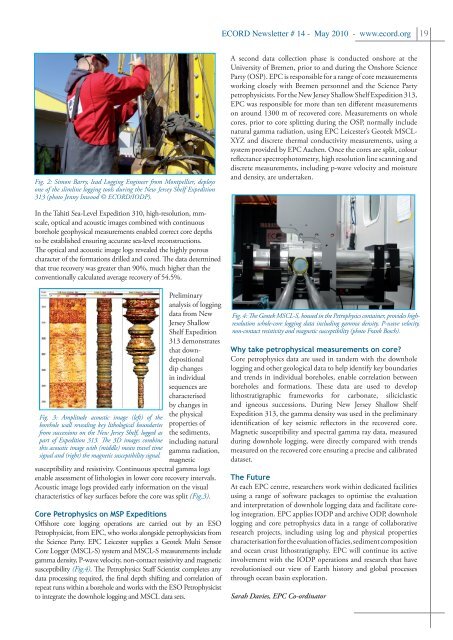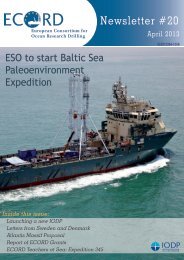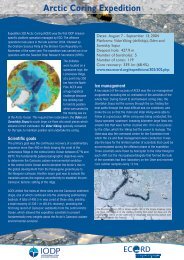18 ECORD Newsletter # <strong>14</strong> - May 2010 - www.ecord.orgSarah DaviesA successful integrated approach <strong>for</strong> petrophysics duringIODP mission-specific plat<strong>for</strong>m expeditionsPetrophysics involves the measurement and interpretation ofthe physics and chemistry of rocks and fluids on a varietyof scales. During Integrated <strong>Ocean</strong> <strong>Drilling</strong> Program (IODP)expeditions, these measurements are made downhole in theborehole and on core, enabling multiple scales of investigationin the same geological environment. The <strong>European</strong> Petrophysics<strong>Consortium</strong> (EPC) is responsible <strong>for</strong> the acquisition, qualityassurance and quality control of the downhole logging data andthe core petrophysics measurements on mission-specific plat<strong>for</strong>m(MSP) expeditions organised by <strong>European</strong> <strong>Consortium</strong> <strong>for</strong> <strong>Ocean</strong><strong>Research</strong> <strong>Drilling</strong> (ECORD). Once collected, EPC are involvedwith data interpretation and the development of collaborativeresearch programmes that directly benefit the scientific objectivesof IODP.The <strong>European</strong> Petrophysics <strong>Consortium</strong>EPC involves three <strong>European</strong> universities, Leicester (UK),Montpellier (France) and Aachen (Germany), with >25 yearsof experience in petrophysics research combining boreholegeophysics, laboratory experiments and geology. More than 250publications in major peer-reviewed journals have been generatedthrough sailing over 50 scientists on ODP & IODP expeditions.Launched in 2003, the consortium provides a <strong>European</strong> focus <strong>for</strong>logging within IODP. EPC links into the international Logging<strong>Consortium</strong>, lead by the Lamont-Doherty Earth Observatory(US) that has been in existence since 1992, which also includesthe University of Tokyo (Japan). Our combined petrophysicalexpertise is available to all scientists involved in IODP.Dr Sarah Davies, at the EPC central office based at the Universityof Leicester, is responsible <strong>for</strong> management of the consortiumand works closely with Head Scientist, Dr Philippe Pezard, atMontpellier and scientists, Professor Christoph Clauser and DrFrank Bosch, at Aachen. Leicester represents the EPC withinECORD and IODP.Fig.1: IODP <strong>Research</strong> Associates within the<strong>European</strong> Petrophysics <strong>Consortium</strong>. From lefttop Dr Jenny Inwood, Dr Louise Anderson, DrJohanna Lofi, from bottom left Annick Fehr andDr Sally Morgan (photos Annick Fehr, JohannaLofi ©ECORD/IODP and John Beck IODP).The current teamof IODP <strong>Research</strong>Associates (Fig. 1)have developedextensive experiencein downhole loggingand core petrophysicson ECORD MSPExpeditions (TahitiSea Level, NewJersey Shallow Shelfand Great BarrierReef EnvironmentalChanges expeditions)and in downholelogging on USIO nonriserexpeditions withthe JOIDES Resolution(sea-trials, and Pacific Equatorial Age Transect and Wilkes Landexpeditions). Working on MSP expeditions and the JOIDESResolution ensures breadth and depth of knowledge, expertise andskills. Each <strong>Research</strong> Associate has their own research interests,including palaeomagnetism, siliciclastic sedimentology, oceanichydrothermal systems, porosity and permeability and life inextreme environments. Secific research projects are addressedthrough the application and interpretation of petrophysical data.In summary the EPC provides high-level scientific and technicalsupport to the IODP and ECORD across the range of highlyvariable environments drilled by the non-riser and mission-specificplat<strong>for</strong>ms, including:• Petrophysics Staff Scientists and Petrophysicists to MSPExpeditions,• Logging Staff Scientists to the JOIDES Resolution,• Expertise <strong>for</strong> development of tailored downhole logging andcore petrophysics programmes,• Dedicated equipment to acquire downhole logging data,including slimline geophysical borehole tools,• Dedicated equipment <strong>for</strong> core logging and discretemeasurements, including Geotek Multi-Sensor Core Loggers(standard and XYZ), a Geotek P-Wave Frame and a ThermalConductivity Probe,• Data calibration and quality control,• Evaluation and interpretation of downhole log and corepetrophysical data.Downhole Logging Data Acquisition on MSP ExpeditionsThe Petrophysics Staff Scientist, in liaison with the Co-ChiefScientists, the Staff Scientist and the Science Party, develops thedownhole logging and core petrophysics programme to meet theparticular scientific objectives of an MSP expedition and con<strong>for</strong>mto the IODP minimum measurement policy. EPC then contractsthe appropriate logging services.EPC Montpellier has undertaken the downhole logging on threeMSP expeditions, Tahiti Sea-Level Expedition 310, New JerseyShallow Shelf 313 and Great Barrier Reef Environmental Changes325. The slimline tool suite (ca. 50 mm in diameter) includesspectral gamma ray, sonic, induction, acoustic imager, opticalimager and magnetic susceptibility probes (Fig. 2). Deploymentof slimline tools was a first <strong>for</strong> ODP/IODP during the TahitiExpedition. For New Jersey Expedition 313, in addition to theEPC logging tools suite, EPC worked with a team from theUniversity of Alberta to complete the vertical seismic profilingexperiments required.Why is downhole logging data important?Logging data provide a continuous dataset, allows physicalproperties to be studied in-situ in the borehole and provides acrucial link between core, core petrophysics data and regionalgeophysical surveys. When combined with other geological data,downhole log measurements enable a full characterisation of thegeology, ‘fingerprinting’ of key surfaces and packages and, wherecore recovery is lower or discontinuous, core-log integration canprovide in<strong>for</strong>mation on the characteristics of the missing succession.Vertical seismic profiling experiments enable key seismic reflectionhorizons to be tied directly to an individual borehole.
ECORD Newsletter # <strong>14</strong> - May 2010 - www.ecord.org 19Fig. 2: Simon Barry, lead Logging Engineer from Montpellier, deploysone of the slimline logging tools during the New Jersey Shelf Expedition313 (photo Jenny Inwood © ECORD/IODP).A second data collection phase is conducted onshore at theUniversity of Bremen, prior to and during the Onshore ScienceParty (OSP). EPC is responsible <strong>for</strong> a range of core measurementsworking closely with Bremen personnel and the Science Partypetrophysicists. For the New Jersey Shallow Shelf Expedition 313,EPC was responsible <strong>for</strong> more than ten different measurementson around 1300 m of recovered core. Measurements on wholecores, prior to core splitting during the OSP, normally includenatural gamma radiation, using EPC Leicester’s Geotek MSCL-XYZ and discrete thermal conductivity measurements, using asystem provided by EPC Aachen. Once the cores are split, colourreflectance spectrophotometry, high resolution line scanning anddiscrete measurements, including p-wave velocity and moistureand density, are undertaken.In the Tahiti Sea-Level Expedition 310, high-resolution, mmscale,optical and acoustic images combined with continuousborehole geophysical measurements enabled correct core depthsto be established ensuring accurate sea-level reconstructions.The optical and acoustic image logs revealed the highly porouscharacter of the <strong>for</strong>mations drilled and cored. The data determinedthat true recovery was greater than 90%, much higher than theconventionally calculated average recovery of 54.5%.Fig. 3: Amplitude acoustic image (left) of theborehole wall revealing key lithological boundariesfrom successions on the New Jersey Shelf, logged aspart of Expedition 313. The 3D images combinethis acoustic image with (middle) mean travel timesignal and (right) the magnetic susceptibility signal.Preliminaryanalysis of loggingdata from NewJersey ShallowShelf Expedition313 demonstratesthat downdepositionaldip changesin individualsequences arecharacterisedby changes inthe physicalproperties ofthe sediments,including naturalgamma radiation,magneticsusceptibility and resistivity. Continuous spectral gamma logsenable assessment of lithologies in lower core recovery intervals.Acoustic image logs provided early in<strong>for</strong>mation on the visualcharacteristics of key surfaces be<strong>for</strong>e the core was split (Fig.3).Core Petrophysics on MSP ExpeditionsOffshore core logging operations are carried out by an ESOPetrophysicist, from EPC, who works alongside petrophysicists fromthe Science Party. EPC Leicester supplies a Geotek Multi SensorCore Logger (MSCL-S) system and MSCL-S measurements includegamma density, P-wave velocity, non-contact resistivity and magneticsusceptibility (Fig.4). The Petrophysics Staff Scientist completes anydata processing required, the final depth shifting and correlation ofrepeat runs within a borehole and works with the ESO Petrophysicistto integrate the downhole logging and MSCL data sets.Fig. 4: The Geotek MSCL-S, housed in the Petrophysics container, provides highresolutionwhole-core logging data including gamma density, P-wave velocity,non-contact resistivity and magnetic susceptibility (photo Frank Bosch).Why take petrophysical measurements on core?Core petrophysics data are used in tandem with the downholelogging and other geological data to help identify key boundariesand trends in individual boreholes, enable correlation betweenboreholes and <strong>for</strong>mations. These data are used to developlithostratigraphic frameworks <strong>for</strong> carbonate, siliciclasticand igneous successions. During New Jersey Shallow ShelfExpedition 313, the gamma density was used in the preliminaryidentification of key seismic reflectors in the recovered core.Magnetic susceptibility and spectral gamma ray data, measuredduring downhole logging, were directly compared with trendsmeasured on the recovered core ensuring a precise and calibrateddataset.The FutureAt each EPC centre, researchers work within dedicated facilitiesusing a range of software packages to optimise the evaluationand interpretation of downhole logging data and facilitate corelogintegration. EPC applies IODP and archive ODP, downholelogging and core petrophysics data in a range of collaborativeresearch projects, including using log and physical propertiescharacterisation <strong>for</strong> the evaluation of facies, sediment compositionand ocean crust lithostratigraphy. EPC will continue its activeinvolvement with the IODP operations and research that haverevolutionised our view of Earth history and global processesthrough ocean basin exploration.Sarah Davies, EPC Co-ordinator







